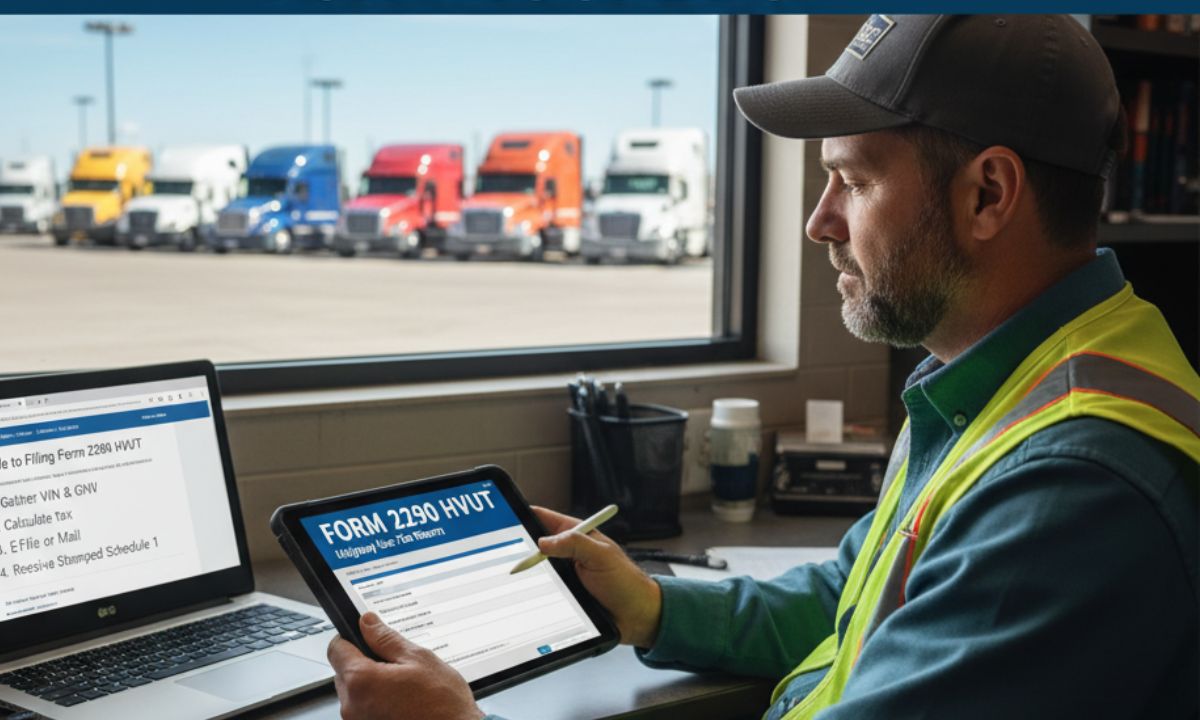Step-by-Step Guide to Filing Form 2290 HVUT
Step by Step Guide to Filing Form 2290 HVUT
For truckers, fleet managers, and owner operators, the IRS Form 2290 Heavy Vehicle Use Tax(HVUT) is mandatory for the operation of vehicles with a taxable gross weight of 55,000 pounds or more. The whole process is intimidating, but basic steps will clearly delineate the entire filing, thus ensuring accuracy, legality, and ease in conducting everything else. The present extensive guide discusses the whole process step by step, what documents to prepare, and the most glaring pitfalls to avoid.
Step 1: Understand What Form 2290 HVUT Is
Form 2290 is a federal tax form from the IRS on which annual highway use tax is imposed on heavier vehicles. The fees collected go toward highway maintenance and infrastructure works all over the United States. Filing helps keep trucks legally registered to operate without interruption.
Step 2 – Determine Who Is Required to File
The following must file the Form 2290:
- Owner-operators with a single vehicle
- Trucking companies managing several fleets
- Heavy vehicles engaged in agricultural and other logging carriers
- Any public highway using a vehicle whose weight is 55,000 or above.
Ownership of the vehicle must still be filed for, even if it is eligible for suspension because of low mileage.
Step 3: Identify Filing Deadlines
The HVUT Tax Year runs from 1 July to 30 June. The filing due date is determined by the date the vehicle is first put into service:
- Filing is due on the last day of the month following the first month in which use commenced.
- If use commenced in July, the deadline would then fall on August 31.
- Filing after the due date will incur penalties, interest, and suspension.
Step 4: Information Must Be Known
Before filing, the following must be known and prepared:
- Individual Employer Identification Number (EIN)-or Social Security Number will not apply.
- Vehicle Identification Number (VIN); must be entered accurately otherwise, rejections will occur.
- Taxable Gross Weight, including the vehicle itself, the trailer, and maximum load capacity.
- Payment Details-EFTPS, Direct Debit, Debit/Credit Card, or Check/Money Order would suffice.
Keeping this data handy would prevent costly mistakes and undesired delays in filings.
Step 5: Choose a Method for Filing.
There are two channels through which Form 2290 may be filed:
E-Filing (Recommended)
And needless to say, e-file providers authorized by the IRS also manage to get such filings done in the fastest of fashions and dispatch the stamped Schedule 1 instantaneously via e-mail.
Filing on paper
- Filing on paper is allowed only for fleets of fewer than 25 vehicles.
- This method is more error-prone and takes longer to process.
- And thus, there is a delay to the DMV registration since Schedule 1 is sent via post.
Step 6: Complete the Filing Process
E-filing via any IRS-approved provider:
- Sign up or sign in onto the site of the supplier.
- Enter the business entity, EIN, and business name.
- Enter the vehicle information including the VIN, month of first use, and gross taxable weight.
- Calculate the tax payable using the appropriate IRS tax tables.
- Make secure online payment through the method you choose.
- Receive stamped Schedule 1 in proof of your payment.
Step 7: Correct Where Necessary
Most e-file providers allow their users to swiftly correct rejected filings without having to resubmit their payments.
Common mistakes include wrong VIN entry, which the IRS electronically corrects.
Step 8: Filing For Credits or Refunds
Credits can be filed for, or refunds can be requested for any vehicle that is sold, stolen, or destroyed or that traveled less than 5,000 miles (7,500 for agricultural vehicles) during the tax year. This could be claimed via amendment upon Form 2290 or the request of credits for use against future tax filings.
Step 9: Know The IRS Penalties
Very costly will be the expense of not adhering to the laws. The IRS will impose these costs on the taxpayer:
- An extra 4.5% per month is charged on failure to file.
- 0.0.5% penalty each month for delay in payment of taxes.
- Also, applicable is interest until the date of payment is made.
A proper e-filing platform will be another great way to protect the taxpayer from penalty charges because its system will send reminders to the taxpayer as the deadline approaches.
Step 10: Keep Schedule 1 Safe
After the filing has been made by the IRS, Schedule 1 (Proof of Payment) is issued. Schedule 1 is essential for the following:
- To renew the vehicle registration at the office of the DMV.
- For interstate trucking.
- Audits and compliance checks with the DOT.
Trucks operating without Schedule 1 are operating illegally.
Step 11: Choosing a Reliable E-Filing Provider
A reputable IRS-approved provider guarantees the best possible filing experience. Look for some of the following attributes:
- Schedule 1 is delivered instantly.
- Error-checkers to avert rejections
- Customer support 24 hours a day, 7 days a week.
- Secure payment processing.
A reliable platform ensures stress-free annual HVUT filing.
Final Observations
Form 2290 HVUT must be filed annually to enable trucks to operate legally and aid in the maintenance of highways throughout the U.S. The step-by-step nature of the process-understanding the requirements, accurate and comprehensive tax details, on-time filing, and good e-file provider- can thereby assist the truckers and fleet operators not incurring penalties, saving on time, and providing uninterrupted operations.
Disclaimer: The information provided in this blog post is for general informational purposes only. While we strive to keep the content accurate and up to date, we do not guarantee its completeness, reliability, or accuracy. Any actions you take based on this information are strictly at your own risk. We are not responsible for any losses, damages, or inconveniences that may arise from the use of this blog.












